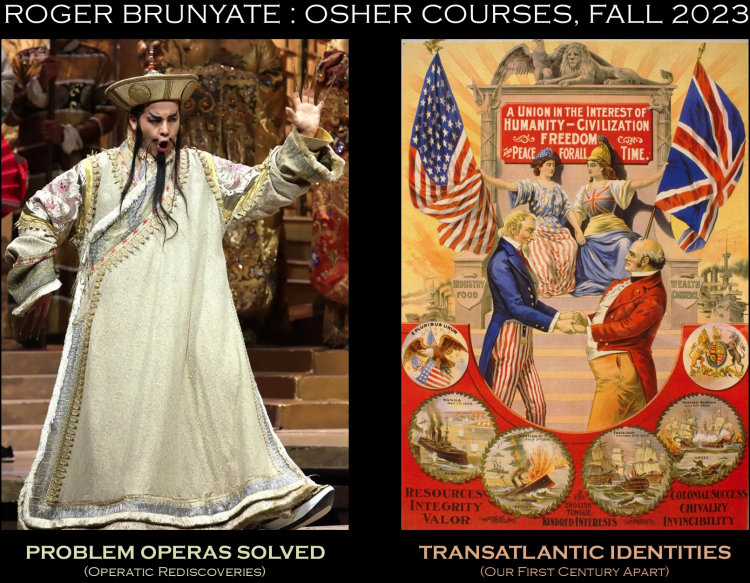

|
|
| Artemisia Gentileschi: Allegory of Painting (Self Portrait) | |
THIS CLASS HAS BEEN UPDATED
This class was given in Baltimore in Spring 2023. I am currently preparing an enhanced version to be
given in Montgomery County in Fall 2024, called WOMEN IN
THE ARTS (click to visit). I will gradually remove the relevant segments of this old course as
I replace them.
| April 4 | |
 | |
| Marie Laurencin / Martha Graham (inset) | RESOURCES |
7. Primadonna Assoluta
Nowhere is the female star more extravagantly worshipped as a goddess (hence the word diva), yet more insistently depicted as a victim, than in romantic ballet and opera. But women seldom were in control. Although bel canto coloratura gives the performer some creative autonomy, actual female opera composers used to be rare: there is the former singer Pauline Viardot (1821–1910) in the 19th century and the formidable English composer Dame Ethel Smyth (1858–1944) at the turn of the 20th, and many more today. On the other hand, female choreographers such as Bronislava Nijinska (1891–1972) in ballet and Martha Graham (1894–1991) in modern dance have played a major part in shaping the dance scene today.
| April 11 | |
 | |
| Lady Edna Clarke-Hall: Cathy and Heathcliff / Jane Austen by her sister Cassandra (inset) | RESOURCES |
8. Authors and Heroines
In England at least, women came to the fore as novelists sooner than they did in other fields; think only of Jane Austen (1775–1817), Emily Brontë (1818–48) and her sisters, or George Eliot (1819–80). You could say much the same of poets like Emily Dickinson (1830–86). Perhaps this is because writers did not need to be admitted to professional academies before taking up the pen. But a further question: are the heroines in novels written by women necessarily more inward, more complex, than those in novels written by men?
| April 18 | |
 | |
| Berthe Morisot: Beneath the Lilac at Maurecourt / Virgina Woolf by her sister Vanessa Bell (inset) | RESOURCES |
9. Group Dynamics
Most artistic groups seem to have been founded and largely peopled by men, but there have been some women who have nevertheless flourished in their company, such as Berthe Morisot (1841–94) among the Impressionists (picture above). The class will consider a lesser-known Impressionist, however, Marie Bracquemond (1840-1916), together with three other remarkable artists: Benedetta Cappa (1897-1977; Futurists), Hannah Höch (1889-1978; Berlin Dada), and Lee Krasner (1908-84; Abstract Expressionists). Segments on novelist Virginia Woolf (1882-1941; Bloomsbury Group) and composer Germaine Tailleferre (1892-1983; Les Six) will bring the total to a round half-dozen.
| April 25 | |
 | |
| Isabella Stewart Gardner (Sargent) / Gertrude Stein (Picasso), Peggy Guggenheim (Janet Scudder) | RESOURCES |
10. Patrons and Collectors
Throughout the 20th century, wealthy women played an extraordinary role in supporting contemporary artists and, eventually, bringing their work to the American public. We have Isabella Stewart Gardner (1840–1924) and the extraordinary museum she bequeathed to the people of Boston. We have the Americans Claribel (1864–1929) and Etta Cone (1870–1949) supporting Matisse and others in Paris, while their friend Gertrude Stein (1874–1946) was one of the first to recognize the genius of Picasso. We have Katherine Dreier (1877–1952), a painter herself, bringing the works of the European avant-garde to New York. And we have the gallerist and collector Peggy Guggenheim (1898–1979) whose museum in Venice is one of the most remarkable collections of Modernist art in the world.
| May 2 | |
 | |
| Judy Chicago: The Dinner Party, detail / Paula Modersohn-Becker (inset) | RESOURCES |
11. Fighting for Her Place
We have encountered pioneering feminists in earlier classes: Christine de Pizan (1364–1430) wrote a book about celebrated women in history; Mary Wollstonecraft (1759–97), the mother of Mary Shelley, published her Vindication of the Rights of Women in 1792; and Virginia Woolf (1882–1941) made an impassioned plea for creative economy in A Room of One's Own (1929). This class will look at their successors: women who have made womanhood an essential part of their work. Their anthem might be the iconic 1971 song, "I am Woman, Hear Me Roar," by Helen Reddy (1941–2020). The images above show a 1906 self-portrait by Paula Modersohn-Becker (1876–1907), the first woman artist to paint herself naked, and The Dinner Party (1979), a monumental work by Judy Chicago (b.1939), with place-settings for 39 women in history around a triangular table.
| May 9 | |
 | |
| Nideka Akunyili Crosby: Nyado / Amanda Gorman and Nkeiru Okoye (insets) | RESOURCES |
12. Made in Our Century
The Twenty-First Century has seen an astounding flowering of talented women in all fields of artistic creation. This final class will celebrate work produced in the past two decades—indeed the past two years, if possible. It would be premature to single out names, but I can comment on the three Black artists shown here. Composer Nkeiru Okoye (b.1972) is of mixed American and Nigerian heritage; her 2020 work Black Bottom was commissioned by the Detroit Symphony Orchestra. Painter Nideka Akunyili Crosby (b.1983) was born in Nigeria; much of her work, which won her the MacArthur Award in 2017, is about her marriage to a white American artist. African American poet Amanda Gorman (b.1998) delivered her poem "The Hill We Climb" at the 2021 inauguration of President Biden, the youngest ever poet to be so honored.
Site hosted by DreamHost